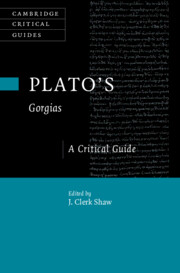126 results
24 - Queering Desire in American Science Fiction
- from Queer Genre
-
-
- Book:
- The Cambridge History of Queer American Literature
- Published online:
- 17 May 2024
- Print publication:
- 06 June 2024, pp 426-439
-
- Chapter
- Export citation
25 - Queering Comics Histories
- from Queer Genre
-
-
- Book:
- The Cambridge History of Queer American Literature
- Published online:
- 17 May 2024
- Print publication:
- 06 June 2024, pp 440-454
-
- Chapter
- Export citation
Chapter 7 - Desire and Argument in Plato’s Gorgias
-
-
- Book:
- Plato's Gorgias
- Published online:
- 25 May 2024
- Print publication:
- 30 May 2024, pp 124-145
-
- Chapter
- Export citation
Chapter 4 - Socrates and Coherent Desire (Gorgias 466a–468e)
-
-
- Book:
- Plato's Gorgias
- Published online:
- 25 May 2024
- Print publication:
- 30 May 2024, pp 68-86
-
- Chapter
- Export citation

Plato's Gorgias
- A Critical Guide
-
- Published online:
- 25 May 2024
- Print publication:
- 30 May 2024
Chapter 33 - Goethe’s Portrayal of Love
- from Part VI - Goethe’s Lasting Significance
-
-
- Book:
- Goethe in Context
- Published online:
- 16 May 2024
- Print publication:
- 23 May 2024, pp 323-331
-
- Chapter
- Export citation
2 - Sexuality in Ancient Egypt: Pleasures, Desires, Norms, and Representations
-
-
- Book:
- The Cambridge World History of Sexualities
- Published online:
- 26 April 2024
- Print publication:
- 16 May 2024, pp 22-42
-
- Chapter
- Export citation
18 - Sexuality and Emotion
-
-
- Book:
- The Cambridge World History of Sexualities
- Published online:
- 26 April 2024
- Print publication:
- 16 May 2024, pp 388-409
-
- Chapter
- Export citation
Chapter 8 - Educating Desire
-
-
- Book:
- The Cambridge Companion to American Utopian Literature and Culture since 1945
- Published online:
- 09 May 2024
- Print publication:
- 16 May 2024, pp 152-166
-
- Chapter
- Export citation
12 - Sexuality in Jewish Traditions
-
-
- Book:
- The Cambridge World History of Sexualities
- Published online:
- 26 April 2024
- Print publication:
- 16 May 2024, pp 250-270
-
- Chapter
- Export citation
2 - Colonialism and Modern Sexuality
-
-
- Book:
- The Cambridge World History of Sexualities
- Published online:
- 26 April 2024
- Print publication:
- 16 May 2024, pp 27-49
-
- Chapter
- Export citation
10 - Sex in Sixteenth-Century Istanbul
-
-
- Book:
- The Cambridge World History of Sexualities
- Published online:
- 26 April 2024
- Print publication:
- 16 May 2024, pp 191-209
-
- Chapter
- Export citation
T. rex is Fierce, T. rex is Charismatic, T. rex is Litigious: Disruptive Objects in Affective Desirescapes
-
- Journal:
- International Journal of Cultural Property , First View
- Published online by Cambridge University Press:
- 09 May 2024, pp. 1-23
-
- Article
-
- You have access
- Open access
- HTML
- Export citation
Chapter 2 - Democratic Eleutheria as Positive Freedom
-
- Book:
- Freedom and Power in Classical Athens
- Published online:
- 04 April 2024
- Print publication:
- 11 April 2024, pp 18-55
-
- Chapter
- Export citation
The Mirror Account of Hope and Fear
-
- Journal:
- Canadian Journal of Philosophy / Volume 53 / Issue 3 / April 2023
- Published online by Cambridge University Press:
- 22 March 2024, pp. 209-223
-
- Article
-
- You have access
- Open access
- HTML
- Export citation
Mapudungun frustrative -fu-: a modal analysis
-
- Journal:
- Canadian Journal of Linguistics/Revue canadienne de linguistique / Volume 68 / Issue 4 / December 2023
- Published online by Cambridge University Press:
- 03 January 2024, pp. 515-554
-
- Article
- Export citation
11 - Queer Bodies in Time
- from Part III - Mapping New Identities and Geographies
-
-
- Book:
- The Cambridge Companion to Contemporary African American Literature
- Published online:
- 14 December 2023
- Print publication:
- 21 December 2023, pp 196-208
-
- Chapter
- Export citation
Chapter 18 - ‘Writing Grows a Habit’
-
-
- Book:
- The Cambridge Companion to Byron
- Published online:
- 02 November 2023
- Print publication:
- 16 November 2023, pp 292-304
-
- Chapter
- Export citation
Chapter 7 - 1816–1817: Childe Harold III and Manfred
-
-
- Book:
- The Cambridge Companion to Byron
- Published online:
- 02 November 2023
- Print publication:
- 16 November 2023, pp 111-125
-
- Chapter
- Export citation
Chapter 4 - Individuation (Truffaut)
-
- Book:
- Alone with Others
- Published online:
- 26 October 2023
- Print publication:
- 09 November 2023, pp 83-100
-
- Chapter
- Export citation



